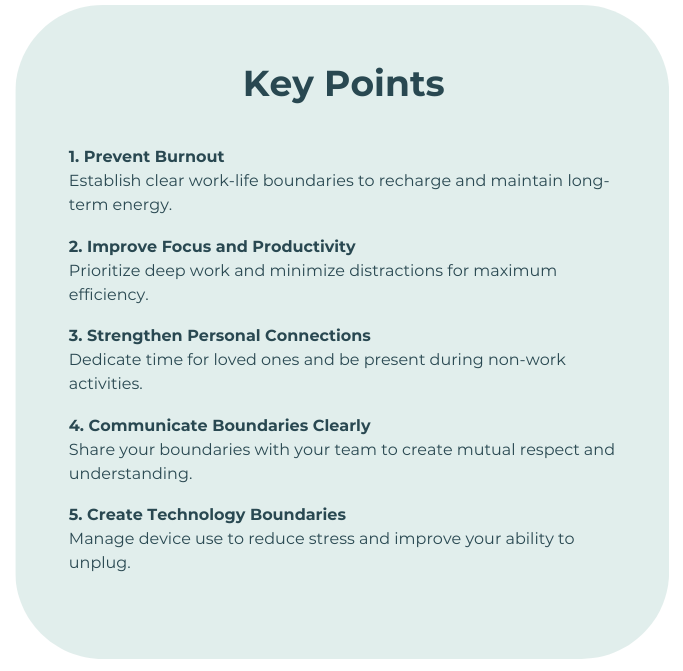Creating Healthy Boundaries: A Key to Mental Well-Being for Leaders
What to Consider When Reading
Which areas of your leadership would benefit most from clearer boundaries?
How can technology management support your mental well-being and focus?
Leadership comes with countless demands—from managing teams and meeting deadlines to balancing long-term strategy with day-to-day problem-solving. With so much on your plate, it’s easy to slip into the habit of always being “on,” answering emails at midnight, taking work calls on weekends, and sacrificing personal time for the sake of your role.
But here’s the truth: without healthy boundaries, even the most driven leaders can experience burnout, decreased performance, and mental exhaustion. Creating and maintaining boundaries isn’t about slacking off; it’s about protecting your well-being so you can lead effectively over the long haul. Let’s dive into how healthy boundaries can improve your mental health and performance—and how you can start setting them today.
Why Boundaries Matter for Leaders
1. They Prevent Burnout
Burnout is one of the biggest threats to modern leadership. It creeps up when you’re constantly pushing without pausing to recharge. Healthy boundaries create space for rest, helping you maintain energy and avoid hitting that wall.
Checklist for Preventing Burnout:
Set daily “off” hours where work is off-limits.
Build time for self-care into your schedule.
Recognize early signs of burnout (fatigue, irritability, reduced focus).
Prioritize recovery as much as productivity.
2. They Improve Focus and Productivity
When you’re constantly juggling tasks without clear boundaries, your brain gets overwhelmed, and productivity suffers. Boundaries help you protect your focus and allocate time to what really matters, allowing you to work more effectively.
Checklist for Protecting Focus:
Block uninterrupted time for deep work.
Say no to non-essential meetings.
Limit multitasking—it dilutes focus.
Set specific times for checking emails.
3. They Strengthen Relationships
Boundaries aren’t just about work; they’re also about creating space for personal connections. Leaders who maintain healthy boundaries are better able to nurture relationships with family, friends, and colleagues—without resentment or guilt creeping in.
Checklist for Building Stronger Connections:
Dedicate time for family and friends.
Be fully present during personal time (no checking work emails).
Communicate your boundaries with loved ones and colleagues.
Protect weekends or evenings for non-work activities.
Quick Poll: What Boundary Do You Find Hardest to Set?
Where do you struggle most with setting boundaries?
A) Turning off work after hours
B) Saying no to requests
C) Protecting personal time
D) Avoiding work-related stress at home
Vote now and see how others approach boundaries!
How to Set Healthy Boundaries as a Leader
1. Get Clear on Your Priorities
Before you can set boundaries, you need to know what matters most. Are you trying to protect family time? Focus on strategic projects? Improve your mental health? Clarifying your priorities will help you draw clearer lines.
Checklist for Clarifying Priorities:
Identify your top three personal and professional priorities.
Reflect on what activities drain your energy the most.
Decide where you want to set firmer boundaries.
Write these priorities down as a reminder.
2. Communicate Your Boundaries Clearly
Boundaries don’t work if no one knows they exist. Let your team and colleagues know what your boundaries are and why they’re important. Most people will respect your boundaries as long as you’re clear and consistent.
Checklist for Communicating Boundaries:
Be direct and respectful when sharing your boundaries.
Use positive language (e.g., “I don’t check emails after 7 PM to recharge for the next day”).
Set expectations early with new colleagues.
Remind people if they cross a boundary—kindly but firmly.
3. Learn to Say No Without Guilt
Saying no is one of the most powerful boundary-setting tools, but it’s also one of the hardest. Leaders often feel pressured to take on everything, but doing so drains energy and reduces effectiveness. Saying no strategically protects your time and focus.
Checklist for Saying No:
Pause before agreeing to new commitments.
Ask yourself: “Does this align with my priorities?”
Offer an alternative solution if possible.
Practice saying no with empathy and firmness.
4. Create Technology Boundaries
In today’s hyper-connected world, it’s easy to let technology blur the lines between work and personal time. Creating boundaries around devices helps reduce stress and improves your ability to unplug.
Checklist for Managing Tech Boundaries:
Turn off email notifications after work hours.
Create tech-free zones (e.g., no phones at dinner).
Use apps to block distractions during focus time.
Schedule regular “digital detox” periods.
Wrapping Up: Boundaries Are a Superpower for Leaders
Setting boundaries isn’t about being rigid—it’s about creating the structure you need to thrive as a leader. When you prioritize your mental health, protect your time, and focus on what truly matters, you’ll show up as a stronger, more balanced leader for your team and yourself.
Start small. Pick one or two boundaries that resonate with you and implement them this week. Over time, these practices will become second nature, helping you lead with clarity, calm, and confidence. Remember: great leadership starts with taking care of yourself first.
Take the First Step Toward your Well-Being
At The Mental Game, we know that navigating life’s challenges requires more than just determination—it requires the right support and strategies tailored to your unique needs. Our team of seasoned professionals is dedicated to helping you build the mental resilience and skills necessary to excel, no matter what life throws your way.
Visit The Mental Game to learn more about our services and schedule your FREE consultation today and take the first step toward a healthier, more resilient mind.

